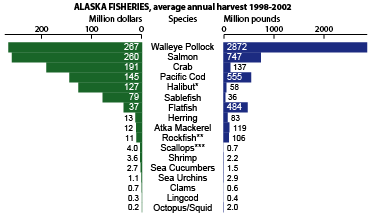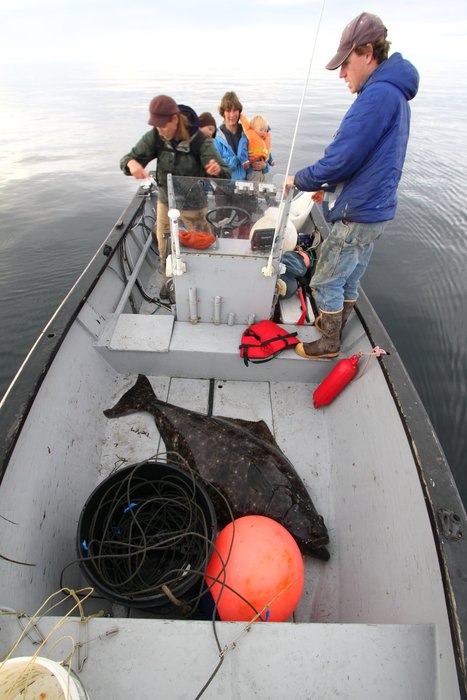Alaska Fisheries
Last modified: 12th August 2019

Fisheries Articles
Subsistence, commercial, and sport fishing are integral to life in Alaska. Fishing brings tourists and visitors to Alaska, provides food for many of its residents, and is an important pillar of the Alaskan economy and culture.

Commercial Fishing
Commercial fishing in Alaska is worth over $1.5 billion annually, counting only the “ex-vessel” value of the fish itself, as paid at the dock. Value-added processing in AK takes this number to $3.6 billion, and including indirect and induced economic output brings the annual total to an estimated $5.8 billion. All of these activities provide tax revenue to the state and employment to residents. Commercial fishing in Alaska targets a large number of fish species, crab, shrimp, clams, scallops and other invertebrates. The most important species by monetary value are pollock, salmon, halibut, Pacific cod, and crab, which together represent over 85% of commercial fishing dollars in Alaska. Alaskan fish and crab are sold around the world and often carry a premium price associated with the image of wild fish found in pristine conditions.
With some notable exceptions the management of fish stocks in Alaska has been very successful and is often cited as a model of fisheries management. In fact many of the “best choices” on the Monterey Bay Aquarium “Seafood Watch” list refer to fish from Alaska including Pacific halibut, wild salmon, and sablefish. The commercial catch in Alaska provides over half of the seafood consumption of the entire United States.
Sport Fishing
Sport fishing is a common pastime among Alaskans, and increasingly attracts non-residents to the state. Most “fishing tourism” focuses on the salmon and halibut fisheries. Freshwater fishing is increasingly popular as well. A 2007 study of the annual economic impact of sport fishing concluded that:
“475,534 resident and nonresident licensed anglers fished 2.5 million days in Alaska and spent nearly $1.4 billion on licenses and stamps, trip related expenditures, pre purchased packages, and equipment and real estate used for fishing.”

Subsistence Fishing
Fish, in particular salmon, are a very important part of the diet for the majority of subsistence-dependent communities in the state. Fish make up over 60% by weight of the annual wild food harvest in Alaska. While not all harvests are monitored by the state and much is unreported, the Department of Fish and Game conservatively estimates the size of the salmon fishery to be over 1 million fish per year (compared to 1.6 million from sport fishing and 167 million from the commercial harvest). Subsistence fishing in Alaska is also is associated with a strong cultural heritage in native communities; its importance extends beyond nutrition and calories. To this end, the state manages all fisheries with subsistence use having a priority over both commercial and recreational fishing.
The state also defines a separate “personal use” fishery for Alaskans only which regulates non-subsistence personal use of fishing gear such as gill nets, traps, and fish wheels. The permitting for these activities is distinct, but the harvest data are usually combined, and both are managed in a similar manner. In reality this fishery more or less just allows a subsistence-style harvest for Alaskans who live outside of designated subsistence zones.
Mariculture
The farming of fish is prohibited in Alaskan waters by state law, but farming shellfish is permitted. Over 50 shellfish farms cultivate primarily Pacific oyster, blue mussels, littleneck clams, scallops, and bull kelp. Most farms are relatively new operations and it is unclear whether mariculture will become an important part of the Alaskan economy.
Created: Jan. 19, 2018